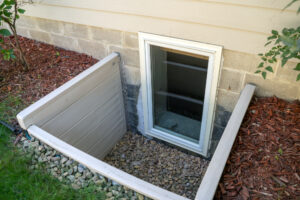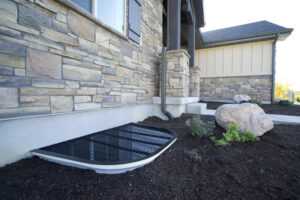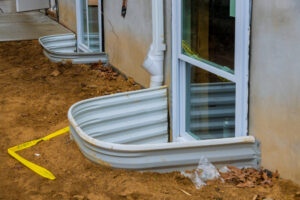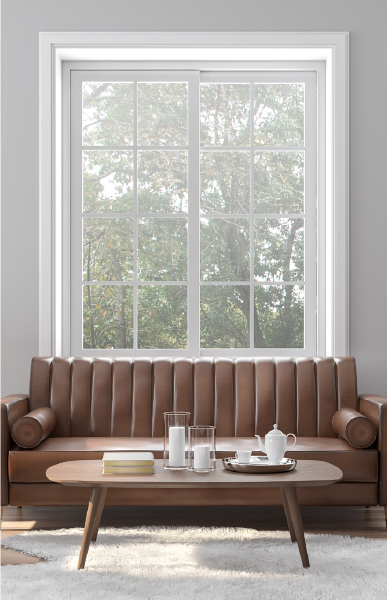When your home has a basement with ground-level windows, window wells can be your best friend—as long as they’re done right.
In this piece, we’ll walk you through everything you need to know when installing window wells for your basement windows. We’ll answer your most pressing FAQs like:
- What is a window well?
- What is the purpose of a window well?
- What are the requirements for installing window wells?
- And, what common window well problems should I look out for?
Let’s dive into everything window wells!
What is a window well?
A window well is an excavated space dug out around basement windows. They increase the natural light in otherwise dark basements, as well as provide an emergency exit route. These holes are typically reinforced with galvanized steel, concrete, or plastic to ensure that water doesn’t seep into the basement through the window. They tend to span the full depth and width of the window in either half-circle or rectangular shapes—frequently determined by the window’s use.

What is the purpose of a window well?
Window wells serve three key purposes:
- Increased natural light: Window wells allow natural sunlight through your basement windows. Without window wells, most basement windows would be underground—with a fabulous view of the dirt. Wells give your basement more light and warmth.
- Emergency escape route: Window wells let you use your basement windows as escape routes in the event of an emergency. Some building codes even require window wells to have escape ladders.
- Window protection: Window wells allow for easier maintenance of your basement windows. This means they’ll last longer and you’ll avoid potential structural damage from leaks and mold.
Window Well Requirements
While a massive hole in front of your basement window is technically a window well, there are several requirements needed to make yours safe and up to code. Certain zoning areas, building codes, or housing committees may also make these requirements mandatory, so it’s well worth knowing the standards.
Window Well Walls
Your window well’s structural integrity depends on its walls. The walls line the dirt and maintain the size and shape of the well. There’s no standard material for window well walls, but there are more common options. These materials come with some pros and cons, so let’s take a closer look!
|
Material |
Pros |
Cons |
| Concrete |
|
|
| Fiberglass |
|
|
| Plastic |
|
|
| Steel |
|
|
Window Well Depth
While there aren’t any rules about window well depth, your window wells should be deep enough to allow your window to open. Generally, this means digging the hole approximately 1 foot below the sill.
There are two reasons for this:
- If your window can’t open, you can’t use it for emergencies. This becomes a safety hazard.
- Your well needs to be deep enough to install proper drainage systems. Without proper drainage, a shallow well can do more water damage during a storm than no well at all.
Window Well Safety Grate
Window well safety grates are a type of protective barrier that can be installed on top of your window well. Made of latticed bars of metal or plastic, window well safety grates create a grid-like cover that fits over your well opening to prevent people, pets, or objects from accidentally falling into the window well, while still allowing light and ventilation to enter the basement through the window.
Depending on the size of your window, your window well might be up to 4 feet deep—that’s a big fall for small children and animals. If you live in a neighborhood with young children or wildlife, a window well safety grate keeps everyone safe while also protecting your home. After all, a scared raccoon in your window well can turn your entire weekend upside down!

Window Well Covers
A window well cover is another type of protective barrier installed over your basement window well. They are typically made out of metal or polycarbonate and are designed to fit securely over the top of your window well, creating a barrier between the ground and the open well below.
While grates have an open grid structure, window well covers are usually solid panels. This means they not only prevent falls, but protect your window well from water and snow damage, leaves, debris, and smaller pests. However, keep in mind that if you choose an opaque window well cover, you will not benefit from extra natural light in your basement.
Both window well grates and covers are also operable from the inside in the event of an emergency and can help fend off any burglars who might see your window well as an open invitation.
Window Well Drains
Window well drains are small holes or channels at the bottom of your window well. These holes ensure that any collected water from storms or snow melt has a way to drain away. At the end of the day, adequate drainage is the key to a long-lasting window well. If water collects in a poorly installed well, it can easily seep through the window and cause damage to the basement walls, flooring, and anything you store there.
Additionally, standing water in your window well can attract insects or rodents and create a breeding ground for mold and mildew. As you can see, properly installed window well drains are essential!
There are two types of window well drains. You can use one or combine the two along with a gravel pit.
Interior drains pull water into a pump that forces it through a series of pipes to a gutter or other deposit area. These drains require an expert to connect your window well drain to the interior of your basement. Don’t try this one at home.
Exterior drains sit in the well itself and connect out to your home’s perimeter drain. These drains are usually covered up by gravel for a cleaner look—you just need to be careful about stepping on them.
Common Window Well Problems
Now that we’ve looked at ways to protect your window well, let’s take a look at some of the most common window well issues.
Poor Window Well Drainage
An improperly functioning well drain is a massive problem. Home windows aren’t designed to seal against constant water pressure. Unlike rain or snow, which falls away from the window, a pool in your window well will place continuous pressure on your window glass and frame.
Eventually, you’ll inevitably experience leaks and structural damage.
The best-case scenario? You notice a small puddle in your basement that you can mop up with a spare towel after work. However, the worst-case scenario is serious (and seriously expensive) water damage to the foundation of your home. And water damage to your foundation doesn’t just put that one wall at risk—it puts your entire house at risk.
To prevent these issues, ensure that your drains are properly installed and that they dump the water far away from your window well. One of the most common mistakes we see with window well drains is homeowners making them too short. If you dump the water just under the well or into the surrounding dirt, it’s still going to create problems. Make sure your drainage system goes all the way out to a sewer or gutter.
Window Well Clogging
Water isn’t the only thing that can ruin your window wells. Open outdoor spaces will always fall victim to debris—whether it be leaves, twigs, or trash from a neighbor’s BBQ. That means that clogged window wells are a common issue.
Many homeowners use window well covers to prevent debris from collecting, but covers aren’t 100% effective. Periodically clearing out your window well is a must—especially if you live in an area with extreme seasons or high wind speeds.
When you clean out your well, you’ll also want to take a moment to double-check your drains. Even a perfectly installed drain can’t function if it’s clogged by leaves. You might need to help it a bit. If you can’t clear your drains, call an expert to clear them out and check for leaks as soon as possible.

Poor Installation
Most issues with window wells come down to poor installation. Double-check these installation must-dos when getting or replacing a window well:
- Window well walls must sit firm and flush against your house walls. Any gaps can pave the way for soil collapses and water damage.
- The soil around your window well must remain compact enough to hold both the well and your home in place. If anything shifts, your well and foundation can be compromised.
- The installation must take place during the proper season. Installing a window well during peak dry or wet season can lead to pressure issues during the opposite months.
- The well has to extend above the soil line. If your well perfectly meets your lawn, it might look nice, but you’re going to have soil spillage.
We know digging a hole doesn’t sound very complicated, but when it comes to installing a window well, it’s best to discuss your options with a professional contractor.
A Good Window Well Starts with a Good Window
Maintaining your window well comes down to monitoring for leaks, drainage, damages, and debris—but your first line of defense starts with a well-installed basement window. For that, you’ll want to reach out to our experts at Window Nation.
At Window Nation, we’re here to help homeowners with all aspects of their window-buying journey and window installation. With dozens of styles, materials, and designs, we’re happy to partner with you to find the ideal window for any room in your home.
Before you build your window well, reach out to Window Nation for friendly expert guidance and a free quote. We’ll make sure you get your project started on the right foot.


